 全地形自动驾驶功能是捷豹路虎研发项目的重要组成部分之一,其中还包括队列驾驶功能。
全地形自动驾驶功能是捷豹路虎研发项目的重要组成部分之一,其中还包括队列驾驶功能。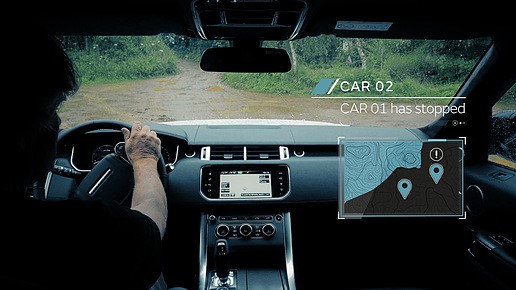 捷豹路虎的工程师表示,互联越野车队中的头车可以发出信号,提醒后车前方存在障碍物。
捷豹路虎的工程师表示,互联越野车队中的头车可以发出信号,提醒后车前方存在障碍物。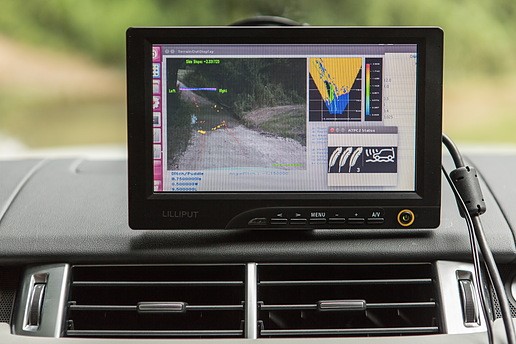 基于地形的速度自适应系统是捷豹路虎的全地形自动驾驶研究项目的组成部分。
基于地形的速度自适应系统是捷豹路虎的全地形自动驾驶研究项目的组成部分。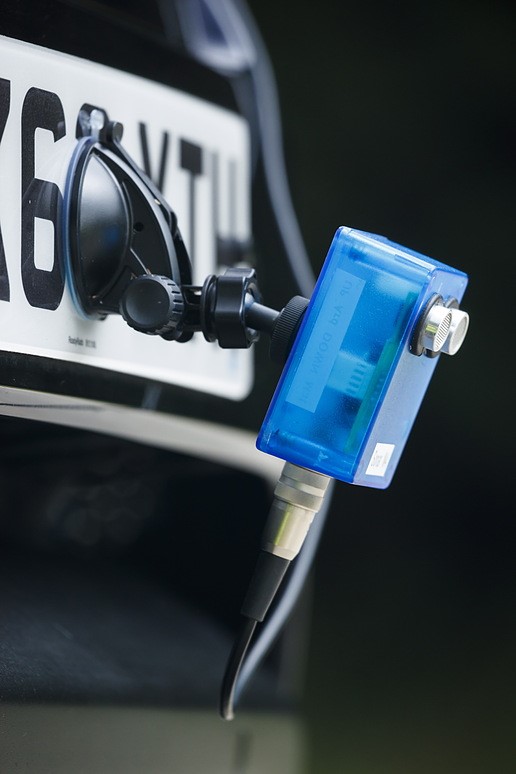 捷豹路虎的地表标识系统采用两个定制超声波传感器,可以扫描车前5米内的地形。
捷豹路虎的地表标识系统采用两个定制超声波传感器,可以扫描车前5米内的地形。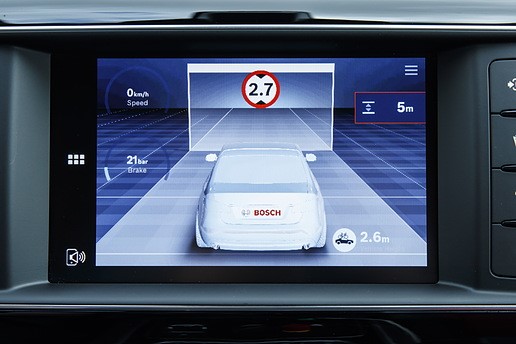 你是否经常忘了车顶的行李架?没关系,捷豹路虎正在开发一个系统,可以提示驾驶员车辆上方存在障碍物或净空高度有限等信息。
你是否经常忘了车顶的行李架?没关系,捷豹路虎正在开发一个系统,可以提示驾驶员车辆上方存在障碍物或净空高度有限等信息。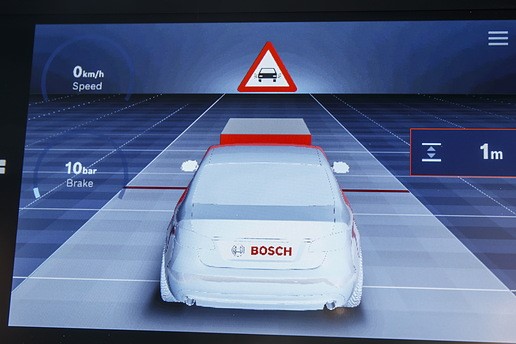 在十字路口或环岛路况下,避免车辆启动时的追尾事故也是捷豹路虎的研发目标之一。
在十字路口或环岛路况下,避免车辆启动时的追尾事故也是捷豹路虎的研发目标之一。 捷豹路虎产品战略总监James Towle表示:“未来,我们将能提供支持任何路面和地形的自动驾驶汽车。”
捷豹路虎产品战略总监James Towle表示:“未来,我们将能提供支持任何路面和地形的自动驾驶汽车。”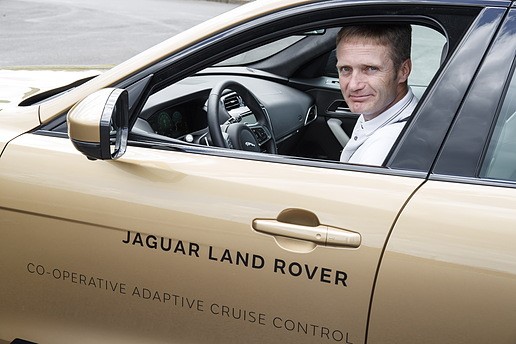 捷豹路虎高级研发经理Chris Holmes表示,“基于传感器的发展,自动驾驶技术也正以相当快的速度进步。”
捷豹路虎高级研发经理Chris Holmes表示,“基于传感器的发展,自动驾驶技术也正以相当快的速度进步。”
未来,如果捷豹路虎(Jaguar Land Rover)全地形自动驾驶汽车的车主决定离开车道开启一段越野旅程,那车辆搭载的自动驾驶技术,也将在碎石小道或山间小路上继续为车主提供指导,自动查看车辆前进方向的各种信息,无论是地表状况、头顶的树枝还是具有威胁性的巨石。对于这一点,捷豹路虎的工程师很有信心。
此外,除了在道路驾驶环境下的应用外,未来V2V(车间)通信功能也将在越野领域发挥作用,前方车辆可以不间断地向后方车辆发送更新有关障碍物和潜在威胁的预警信息。
捷豹路虎开展了一项专注越野互联车队的研发项目,以上这些功能都是项目研发中的一部分。捷豹路虎产品战略总监James Towle表示,“未来,我们将提供支持所有路面和地形特征的自动驾驶驾驶功能。”
在未来四年中,捷豹路虎将借助一队拥有100辆车的车队,进行互联/自动驾驶技术真实驾驶工况测试。目前,捷豹路虎至少正在进行10个相关研究项目。
但是,这并不意味驾驶员可以在车辆穿越丛林时随便打盹。Towle解释说,自动驾驶系统和无人驾驶系统之间存在明显区别。因此,捷豹路虎的研发主要集中在为驾驶员提供技术支持。Towle表示,“我们不是想简单地用自动驾驶系统替代驾驶员。”
此外,捷豹路虎还决心保留旗下产品的固有特色,但同时从另一方面培养用户对车辆及驾驶员辅助技术的信心。
传感器支撑起自动驾驶系统
在进行自动驾驶汽车项目时,捷豹路虎与博世(Bosch)合作,共同整合下一代传感器技术,并提升车载计算机的处理能力。“举个例子,我们正在提升立体摄像头的像素,”博世消费者首席工程师Sven Lanwer表示,“将来,就可以提供更加精准的信息;此外,互联车辆通信网络的带宽也将有巨大提升,从而保证更多功能的实现。”
Lanwer正在与捷豹路虎高级研发经理ChrisHolmes开展密切合作。Holmes曾表示,传感器技术的不断进步与软件开发的结合,可以带来更多全新解决方案。比如,捷豹路虎为了实现停车协助功能而开发的超声波传感器,现在也成为了公司预测性越野自动驾驶汽车研发项目的一部分,可用于预测地表的变化。
除了信息质量需要提高,对信息数量的控制也必不可少。如果不进行信息筛选就直接提供给驾驶员,造成接收信息过多,是否也会带来一些危险?
“这个问题很难回答,”Holmes表示,“在公司占地300英亩的英国试车场中,我们向你展示的是一些已经成型的基本组成部分。这就是一种可能性不断扩展的艺术,随着传感器和软件方面的进步,自动驾驶技术也不断高速发展,可以实现一些高级功能。我们正在进行多种尝试,寻找提示驾驶员的最佳方法。”
捷豹路虎的工程师向SAE《汽车工程》杂志(微信号:SAEInternational)透露,公司可能会增加对抬头显示器和语音命令系统的应用。但在危险或紧张环境下,驾驶员最应该关注的是车外的情况,因此这个时候在车辆显示器上推送各种信息毫无作用。分级语音警报可以在不营造紧张气氛的情况下为驾驶员提供预警信号吗?也许有可能。
当然了,驾驶员必须充分信任车辆提供的信息,正如同他们信任今天的制动和转向系统一样。
Towle表示:“智能汽车永远都不会分心,甚至可以提前‘感知’到水平线以外的情况。我们进行全地形自动驾驶研究,主要是为了尽可能地扩大自动驾驶汽车在真实生活中的适用范围,无论是道路行驶还是越野环境,当然还有不同的天气状况。”
他补充说,随着时间的推移,驾驶员的确需要学着去“相信”自动驾驶汽车。
捷豹路虎对自动驾驶的未来充满信心。公司互联技术总监Peter Virk补充说:“在不到未来三年内,我认为全世界售出的所有新车都将会是互联车型。”但他同时强调,在适当的时间为驾驶员提供适当的信息必不可少。
DSRC技术是实现队列驾驶功能的关键
虽然捷豹路虎在自动驾驶汽车研发中采用了大量的既有技术,比如超声波雷达、雷达、立体摄像头、激光雷达和无线电系统等,但未来此类技术的发展可能更多局限在进化层面,而难以实现根本的变革。
捷豹路虎向笔者展示了一系列公司的自动与半自动系统重点研发项目,其中包括一项基于地形的自适应车速调节系统(Terrain Based Speed Adaptation)。具体来说,该系统可以利用车辆的立体摄像头扫描前方道路,然后依据返回的地表信息做出决定,自动适当调节车速,并通过悬挂设置提升乘驾舒适度。
地表标识(Surface ID)是全地形自动驾驶技术的基本参数之一。车辆的超声波传感器可以扫描车辆前方5米内的情况,为人工智能提供信息以评估周边环境,然后做出捷豹路虎口中的“适当的决定”。捷豹路虎扫描了沙地、碎石及雪地等路面信息,并将其写入数据库。而后,车辆的超声波雷达可以交叉参考数据库内的数据,而后进行最优的设置。
捷豹路虎的互联队列系统(Connected Convoy System)采用无线专用短程通信(DSRC)技术,可以利用车辆位置、车轮滑移、悬挂高度变化及车轮铰接等多种信息,实现队列驾驶功能。DSRC技术可以配合一些现行技术发挥作用,比如全地形前进控制(All TerrainProgress Control)和地形响应(Terrain Response)设置等。
虽然看起来这些技术可以在军事领域发挥作用,但捷豹路虎的发言人表示,公司的互联队列系统主要针对民用领域。
捷豹路虎开发的另一个新系统名为净空高度协助(Overhead ClearanceAssist),可以在行车方向上存在下挂树枝或在进入净空高度较低路段时,警告驾驶员车顶上放置的物品可能会造成一些问题。该系统基于摄像头发挥作用,驾驶员在使用时仅需输入车顶物品的高度,方便系统计算车辆总高度,从而在车辆进入净空高度较低区域时提供警示。这一系统同时支持道路和越野应用。
捷豹路虎正在研发的另外一项道路技术是“安全驶离(Safe Pullaway)”系统。该系统可以协助驾驶员避免与其他车辆发生碰撞,一般在环道或十字路口等驾驶员精神压力相对较高的环境下发挥作用。具体来说,车辆搭载的前向立体摄像头将密切关注车辆前方的区域。如果在摄像头检测到前方存在物体的情况下,驾驶员还试图从静止开始加速,车辆不但不会前进,还会给出视觉警示。
在捷豹路虎的道路技术演示中,有一处特别值得注意 – 为了增强现有的雷达自适应巡航控制系统(ACC),公司开发了一款基于车辆-基础设施(V2I)和车间(V2V)通信技术的升级版协作自适应巡航控制系统(C-ACC)。
DSRC无线技术允许车辆在“几毫秒”的时间内对前车的信息做出反应。后车将跟随前车,以同样的速度前进,并在同样的时刻刹车。DSRC技术是自动队列功能的基础,队列车辆之间的信号延迟仅为0.4秒。现阶段,根据各个市场不同,ISO标准对ACC系统的延迟规定在0.8秒。
经过笔者的亲身感受,队列驾驶车辆在重新启动时最初令人担忧,而后又让人放心。紧跟在前车后方可以提高车辆雷达ACC系统的效果,但却很容易让驾驶员精神紧张,毕竟驾驶员不得不克服自己在看到前车的刹车灯时,跟着猛擦刹车的反射动作。
现阶段,相关法规将如何规定,我们还不得而知。但是正如其他自动驾驶功能一样,即使雷达ACC系统可能已经在合理范围内证明了自己的功能,但这个复杂系统到底何时才能上市,这仍取决于法律法规和驾驶员/乘客的接受程度。
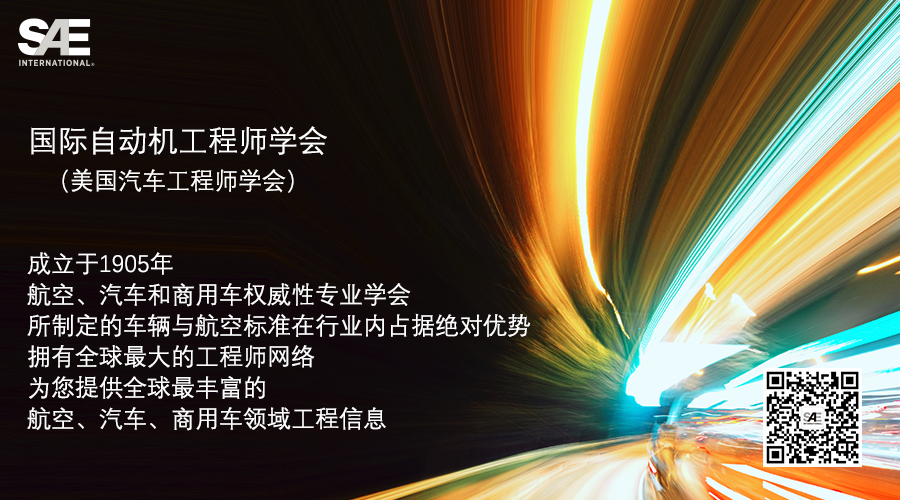
JLR prepares to leave the road — autonomously
JaguarLandRover engineers are confident that when a driver of one of their future all-terrain autonomous vehicles wants to leave the pavement, technology will continue to provide guidance along gravel lanes or mountain trails, automatically checking ahead for anything from changing surfaces to overhead branches and threatening boulders.
And just as future V2V (vehicle to vehicle) communications capability will become available for autonomous on-road driving, it will also be available for off-road, constantly transmitting and updating warning information about obstacles and potential dangers to any following vehicles.
All this is part of a significant R&D program focused on off-road connected convoys. “In the future we will offer autonomous driving over any surface or terrain,” said JLR Product Strategy Director, James Towle.
Over the next four years, JLR will conduct real-world testing of Connected and autonomous technology using a fleet of 100 vehicles. Currently, it is running at least 10 main research projects in this area.
But that doesn’t mean the driver can take a nap while the vehicle claws its way through the jungle. There is a distinct difference between autonomous and driverless system capability, explained Towle. So R&D is concentrating on giving the driver focused technology support: “We aren’t looking at simply replacing the driver,” he said
JLR is also determined to retain the established character of its products while imbuing a different type of emerging trust in the vehicle and its driver-support technologies.
Sensor building blocks
For its autonomous program, JLR is collaborating with Bosch in integrating next-generation sensor technology and processing power. “For example, we are adding more megapixels to stereo cameras,” said Bosch Customer Chief Engineer, Sven Lanwer. “This will increase in future to provide more precise information; bandwidths are going up to give greater capabilities.”
Lanwer works closely with Chris Holmes, JLR’s Senior Manager Research, who said advances in sensor technology allied to software are providing significant new solutions. Ultrasonic sensors developed from those used as parking aids, are part of JLR’s predictive off-road autonomous R&D to anticipate surface changes.
While information quality needs to improve, increased quantity needs to be controlled. Is there a danger of giving the driver too much information by not filtering it sufficiently?
“It is a difficult question to answer,” stated Holmes. “What we are showing you [at JLR’s 300- acre Gaydon, U.K., proving ground] are some baseline building blocks that we are putting in place. It is the art of the possible. Technologies are evolving at a rapid rate based on sensor improvement and, coming together with software advances, are giving high level capabilities. So we are looking at many ways of how to advise the driver.”
This could include increased use of head-up displays and certainly of voice-command systems, the engineers told Automotive Engineering. It is no use in potentially dangerous or stressful situations putting up information on a screen while the driver’s eyes are focused where they should be—outside the cabin. Could tonal gradations of voice alert be considered to soothe and provide confidence without adding to tension? Possibly.
Certainly the driver must have confidence and belief in what the car is telling them, just as he or she has confidence today in brakes and steering operating safely.
Said Towle: “An intelligent car is never distracted because it is connected—it can even be aware of situations developing over the horizon. The aim of our autonomous all-terrain driving research is to make the self-driving car viable in the widest range of real life, on and off-road driving environments and weather conditions.”
He added that over time the driver would indeed learn to “trust” the vehicle.
JLR is confident that this is going to happen. Peter Virk, JLR’s Director of Connected Technologies, added: “In less than three years I predict that every new car sold in the world will be ‘connected’.” But he also stressed that giving the right information at the right time to the driver was essential.
DSRC is key to convoying
While the company is making use of off-the-shelf and established technologies like ultrasonics, radar, stereo cameras, LiDAR and radio systems, these are being improved although it is more a matter of evolution than revolution.
Key autonomous or semi-autonomous programs demonstrated by JLR to the author included Terrain Based Speed Adaptation, which adapts speed automatically to changing surface conditions and also improves comfort via suspension settings. A stereo camera scans the route ahead with features mapped against different target speeds, making decisions about appropriate speeds for conditions.
Surface ID is a fundamental element of autonomous driving on any terrain. Artificial intelligence can assess surroundings and make what JLR describes as “appropriate decisions,” ultrasonic sensors scanning 5 m (15 ft) ahead of the vehicle. Surfaces including sand, gravel and snow are scanned-in to create a database, which is cross-referenced with real time ultrasonic returns, allowing the vehicle to pre-emptively optimize relevant settings.
The Connected Convoy System using wireless Dedicated Short Range Communications (DSRC) uses information including vehicle location, wheel-slip, changes to suspension height and wheel articulation. The DSRC works with current production technologies such as All-Terrain Progress Control and Terrain Response settings.
Although seemingly useful for military applications (a Land Rover bailiwick), a JLR spokesperson said the R&D Connected Convoy system is focused only on civilian applications.
Overhead Clearance Assist, another new system, is aimed at both on- and off-road applications. It can cope with overhanging branches off road or warn the driver that roof-carried objects such as bicycles could cause a problem when entering a low-overhead parking structure. To operate the camera-based system, the driver simply adds the height of anything carried on the roof to the known height of the vehicle and would then be alerted by the system to any likelihood of entrance to a low height area.
On-road technologies under development include a “Safe Pullaway” system to prevent a vehicle colliding with one in front, typically at roundabouts or intersections when driver mental workload is high. A forward facing stereo camera keeps watch on the area immediately ahead of the vehicle. If the driver tries to accelerate from standstill and an object ahead is detected, the car will not move and a visual warning is shown.
Of particular interest in JLR’s on-road technology demonstrations was Co-operative Adaptive Cruise Control (C-ACC) using vehicle-to-infrastructure (V2I) and V2V communications to enhance existing radar ACC systems.
DSRC wireless is used to facilitate reaction within “a few milliseconds” to messages from the vehicle in front. The following vehicles would brake at precisely the same moment and rate as a lead car. This could facilitate autonomous platooning, with a gap time between vehicles of as little as 0.4 s. At present, depending on market, ISO standard for ACC is about 0.8 s.
Sampled by the author on a track, the effect was both worrying (initially) and reassuring (subsequently) as the system was activated. Following very close behind another vehicle improves radar ACC effectiveness but does concentrate the driver’s mind, with a need to overcome the reflex action of braking hard as the red lights of the vehicle ahead illuminate.
Quite what the law would make of this has not been defined. But like most aspects of autonomous driving, it will be legal and driver/vehicle occupant acceptance of such apparently esoteric systems that will determine their introduction—even though their efficacy may have been proven beyond reasonable doubt.
Author: Stuart Birch
Source: SAE Automotive Engineering Magazine
等级
打分
- 2分
- 4分
- 6分
- 8分
- 10分
平均分
